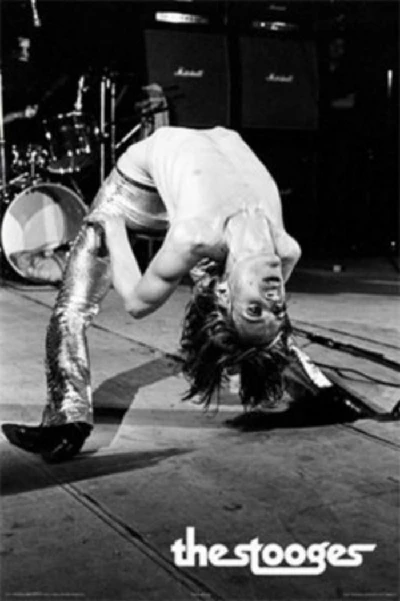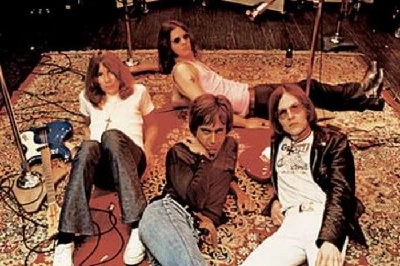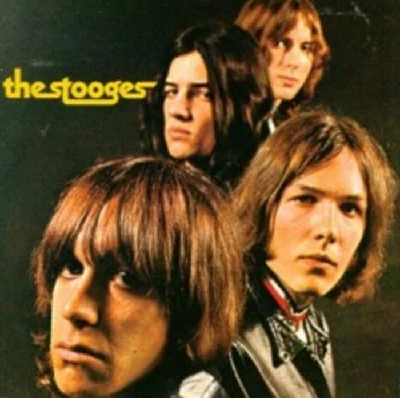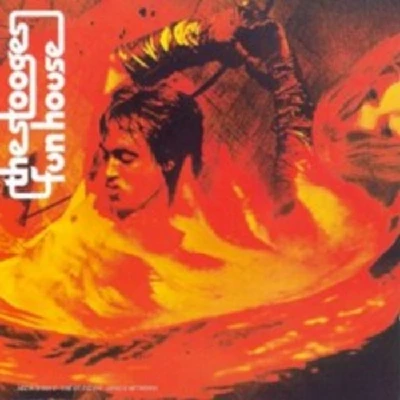published: 10 /
1 /
2009
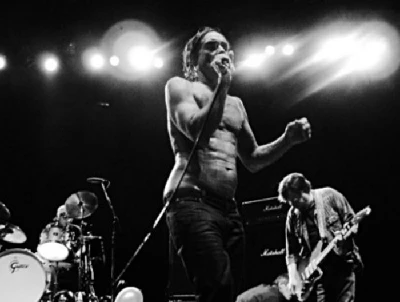
In tribute to their guitarist Ron Asheton who died recently, Jon Rogers examines the career of the Stooges, and reflects upon their influential first two albums, their self-titled 1969 debut album 'The Stooges' and its 1970 sequel, 'Fun House'
Article
It’s hard to overstate the importance of Detroit’s proto-punk quartet The Stooges. Their first two albums are universally praised and seen as essential listening to any fledgling rock band interested in basic, primitive, stripped down Bo Diddley riffs.
The Sex Pistols, who articulated a general disdain – at least in public – for almost all music that had preceded them were suitably impressed to cover 'No Fun' and the influence of the Michigan band can be felt in the likes of everyone from Sonic Youth to the House of Love.
The Stooges were very much a product of their upbringing. All four members of the band – Iggy Pop (aka Jim Osterberg), Dave Alexander and the Asheton brothers, Ron and Scott – grew up in Detroit, The United States’ “Motor City”. The city already had a strong musical heritage thanks to the sweet soul of Berry Gordy’s Motown label but te Stooges took inspiration directly from the car manufacturing heart of the city. Drawing inspiration from the noise of the industrial machinery. In a profile of Pop on 'The South Bank Show', the band’s singer explained that in songs like 'I Wanna Be Your Dog' and 'No Fun' he had tried to capture the sound of the car manufacturing plants that at the time dominated the city.
The band also picked up on the fundamental cultural shift that had taken place in recent times. The country had only just been swept up in euphoria of “peace and love” with the rise of the hippie ideal and the desire to go to California and wear flowers in your hair. The idealism though had been shattered leading to protests – and rioting – in many of the country’s main cities as people became disillusioned with the war in Vietnam, the state of race relations. The hippie idealism had turned sour and was effectively embodied in Charles Manson and his “Family”.
The Stooges provided a grittier soundtrack of basic, almost animalistic, stripped down, primal rock ‘n’ roll based on the blues as well as some of the band’s favourite groups like the Doors and the Rolling Stones. It was a radical change from the sweet harmonic sounds of groups like the Supremes and The Four Tops. Effectively, the Stooges embodied what Lester Bangs described as rock ‘n’ roll’s “raw wail from the bottom of the guts”.
The band emerged after the various members had played in a variety of similar Detroit/Ann Arbor-based garage bands like the Prime Movers and most famously the Iguanas, for whom Pop had been drummer.
The Stooges made their live debut just six months before signing with Elektra in October 1968. From various accounts the band’s early shows were pure spectacle, even if they usually only lasted around 20 minutes. As Iggy Pop told Clinton Heylin in his book 'From the Velvets to the Voidoids' : “We weren’t interested in writing a song or making a chord change. I didn’t bother with anything like that until I had a recording […] Our music was flowing and very conceptual. We’d have just one song called 'Wind Up'.”
And the focus was certainly on Pop, the man who is generally credited with inventing stage-diving, as the actual musicians had barely mastered the rudiments of their respective instruments and had just come out of the garage. “Usually we got up there and jammed one riff,” Ron Asheton told Heylin. “And built into an energy freak-out, until finally we’d broken a guitar or one of my hands would be twice as big as the other and my guitar would be covered in blood.”
Early shows were very experimental with the band using items like 50-gallon oil drums, a food blender, a washboard and a vacuum cleaner on stage. Or simply adding loads of feedback through the PA. And then there was the visual antics of singer Pop on stage. At one of the band’s regular gigs at Detroit’s Grande Ballroom Pop came on stage with his face painted silver. Considering some of the later tales of Pop’s on-stage antics of self-hatred and self-harm as well as goading the audience into violence, simply painting his face silver was relatively subdued behaviour but it was still quite a radical act for late 1968 and certainly got him noticed. Another time Pop turned up on stage in an aluminum ‘suit’ and proceeded to slowly take it off.
The band would utilise that aspect of the carnivalesque and vaudeville throughout their short career, taking it further and further. And infamy followed them too. At an August ’68 gig at Mother’s, the vinyl pants Iggy was wearing on stage split, exposing himself. That incident lead to a court appearance and a $40 fine for disorderly conduct. Pop’s stage antics weren’t merely an elaborate act or a performance but more a psychodrama where anything could happen, and it usually did.
Although still getting to grips with their instruments the band made up for their limited technical ability in other areas. According to Pop, it was Ron Asheton that came up for the classic riffs to 'I Wanna Be Your Dog' and 'No Fun'. “His big contribution to the group initially was coming up with those two world-class eternal riffs,” Pop told Brett Callwood for 'The Stooges: A Journey Through the Michigan Underworld'. “I’d get very excited when I heard this guy play something that just sounded great.”
The quartet landed a $5,000 recording contract with Elektra thanks to the label’s A&R head Danny Fields who had come to Detroit to check out the up and coming – and slightly older – MC5. As has been well documented before, during a conversation Fields had with the MC5’s Wayne Kramer, Kramer recommended that Fields go and see their “baby brother band” referring to the Stooges. Having seen both bands live and contacting his boss the head of Elektra Jac Holzman both groups were offered contracts. Interestingly the MC5 were offered $20,000.
The Stooges didn’t waste any time and headed to New York in June 1969 to record their debut at The Hit Factory. Sitting behind the controls was former-Velvet Underground multi-instrumentalist John Cale, now a house producer, with Elektra who took on the job of knocking the band’s rudimentary style into shape.
In their naiveté the band set up their equipment, including their Marshall stacks, just as if they were about to play a gig and set the volume at the maximum. An argument then ensued between Cale and the band that you couldn’t record properly like that with a compromise eventually being reached where the band wouldn’t play at the maximum volume of 10, but 9 instead. As Ron Asheton recollected in Callwood’s book, “He [Cale] just let us do our own thing. He didn’t come in and tell us what to do.” Recording was done quickly with the eight songs recorded in a mere two days. The band’s early live favourites like 'Asthma Attack' and 'Dance of the Romance' were dropped in favour of what were considered more tuneful songs.
The eponymous album, eventually released in the States in August, is now a bona fide classic. Opening up with the youth anthem to boredom and alienation '1969', the album nails its colours to the mast in just over four minutes of frustration, guitars and noise. The band top that though with what is now perhaps their best-known song 'I Wanna Be Your Dog' with its monolithic drone and simple Bo Diddley pounding beat. The first side was then completed with the narcoleptic 'We Will Fall', a 10 minute meandering pulse that featured Cale on viola. Side two was more classic rock ‘n’ roll featuring the now punk standard 'No Fun' as well as 'Real Cool Time' and 'Little Doll'.
When the album was released it was met with almost universal indifference. The record buying public certainly weren’t interested as it didn’t make the charts in the UK and only made it to 106 in the USA. Dismissed at the time by Fields as a “commercial curio” the album has been hailed as a precursor to the punk explosion less than a decade away. The critics weren’t enamoured of it either. Lenny Kaye, Patti Smith’s future guitarist, then writing for 'Fusion' dismissed the band as “a pale copy of the early Rolling Stones”. 'The New York Times' begrudgingly said that “the Stooges makrfairly good records”.
Along with the MC5’s debut 'Kick Out the Jams', 'The Stooges' album stood out on its release. Even coming out of the Motown Hitsville factory the same year was the Temptations' 'Cloud Nine', Sly and the Family Stone were getting increasingly agitated and political with 'Stand!' and Leonard Cohen delivered his introspective 'Songs From a Room'. Over in the UK pastoral folk singer Nick Drake released his first album with 'Five Leaves Left', the Beatles immortalised 'Abbey Road' and Led Zeppelin hit the stratosphere with their second album.
Whilst in New York helping to promote the album the group played one of their most notorious gigs – the State Pavilion in Queens with the MC5. Pop took to the stage covered in a mixture of oil, glitter and peanut butter whilst the band the rest of the band hammered out a monotonous drone. Towards the end of their short set Pop started beating and cutting himself with a couple of drumsticks.
The gig was just one in a whole series that the band undertook to promote their record. It was during this time that songs for what would become their masterpiece were starting to take shape and the band were becoming more accomplished on their instruments. Although far from virtuosos at least now they knew the basics. As Ron Asheton told Callwood, “We actually learnt how to play on stage. Just by sheer repetition, by shows, play, play, play. You can tell we had progressed. Everyone is a little bit more knowledgeable and fluent on their instruments.”
Iggy Pop had been disappointed by Cale’s production of their debut and the plan this time around was to capture the live assault of the band on tape and Holzman eventually got one-time Kingsman Don Gallucci in the job at Elektra Sound Recorders in Los Angeles in May 1970. In order for the band to have the right environment – recreating the band live on stage both Gallucci and the engineer Brian Ross-Myring stripped the studio and had the group set up as if they were about to play a gig. Pop apparently spent most of the recording time writhing on the floor with a basic hand mike.
With the basic structures of the songs already written and worked out Pop knew exactly what he wanted it to sound like: “It had a unity and a reality before we ever got into the studio, I knew exactly what I wanted it to be.” To flesh out the sound the band recruited jazz saxophonist Steve Mackay.
The album 'Fun House', named after the rundown farm the band lived on, was largely recorded live in the studio with most songs only benefiting from the odd overdub or re-take. The closing 'LA Blues' itself was, according to Ron Asheton, done live in one take.
'Fun House' kicks off where the debut stopped. 'Down in the Street' sees the band set off once more with a monumental, simple riff and has Pop as a hustler stalking the downtown area late at night. The pace is kept up on the swaggering 'Loose' and lustful 'TV Eye'. The band’s rudimentary take on rock ‘n’ roll gradually gets more interesting as the record progresses. The band loosen up and start to experiment. The title track has Mackay splatter his tenor sax all over the place as the rest of the band seem to just improvise around a simple beat. Pop detailed the sort of thing that went on at the Fun House when the band weren’t playing. The closing 'LA Blues' starts with a chilling cry of pain and anguish from Pop and disintegrates from there into a wonderful, chaotic mess of near free jazz experimentation as the listener is battered by the assault.
'Fun House' would eventually be unleashed unto the public in July 1970 and represent their most accomplished work. While their debut contained some all-time classics like 'I Wanna Be Your Dog', the group suffered from a lack of confidence and knowing exactly what they wanted to achieve. With 'Fun House' the band at least had a rudimentary understanding of their instruments and had a focused idea of what they wanted to achieve – and that translates onto the release. Not that the general public at the time cared though. The record failed to make any sort of impact on the charts either side of the Atlantic. Lester Bangs though out did himself in his praise, penning a lengthy review for 'Creem' which ran over two weeks.
The Stooges would never really be the same after that. The group would be taken in a more traditionalist rock format when James Williamson would be brought in on guitar, pushing Ron Asheton on to the bass. But the band was effectively falling apart already before the recording of the disappointing 'Raw Power' (which wasn’t helped by lacklustre production by David Bowie) as Pop as well as other members of the band had picked up a heroin habit whilst in LA. The change was noticeable too in the band’s name. Previously it had just been the Stooges, a much more democratic situation than Iggy and the Stooges that 'Raw Power' was put out as.
The new look band did have its moments – as bootleg recordings of songs like 'Open Up and Bleed' and 'Pin Point Eyes' reflect - but they would never really attain the heights previously achieved.
Picture Gallery:-
